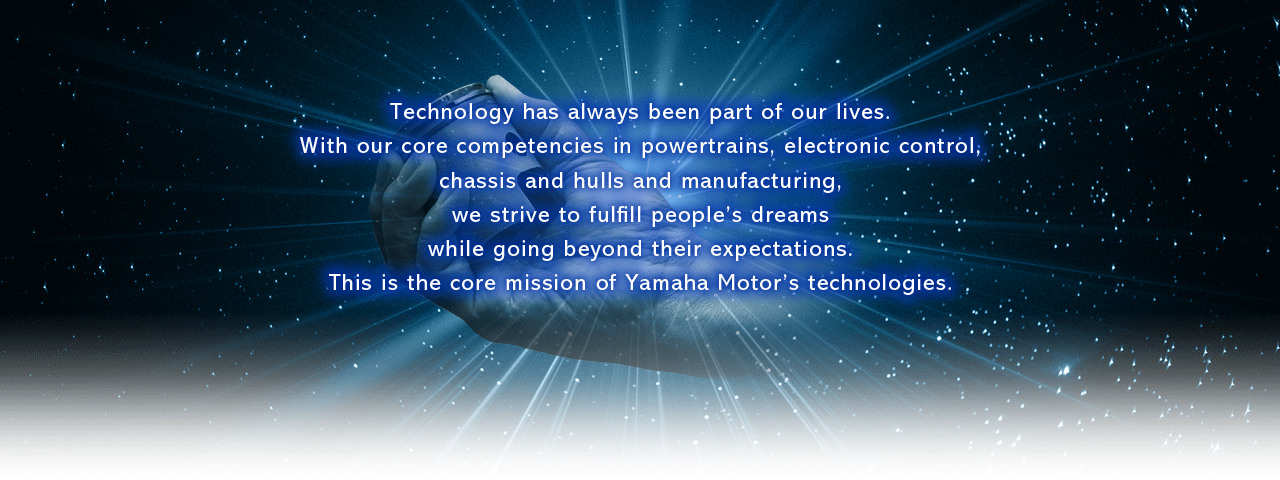Technologies to Realize Yamaha Motor’s Long-Term Vision
A statement by Yamaha Motor’s chief of technology and R&D

The environment for mobility is said to be undergoing a once-in-a-century revolution, including efforts to achieve carbon neutrality, the major steps made toward “connected, autonomous, shared, and electric” (CASE) vehicles, and new electric vehicle (EV) manufacturers joining the industry. Yamaha Motor has made Transforming Mobility part of its Long-Term Vision and is conducting research and development to address and bring change to a variety of mobility-related societal issues. The Company is also pursuing the development of technologies that bring fun to mobility, one of the intrinsic values of personal mobility, while never straying from the unique style of Yamaha.
Yamaha Motor’s Course of Action for Achieving Carbon Neutrality
Various governments and a myriad of companies have set targets for achieving carbon neutrality between 2030 and 2060. Nonetheless, as carbon is very deeply embedded in our lives, achieving a carbon-free world will likely be a daunting challenge. With a view to achieving carbon neutrality in mobility, many technological methods are being examined, such as hybrid electric vehicles (HEVs), plug-in hybrid electric vehicles (PHEVs), EVs, fuel-cell vehicles (FCVs), and e-fuels. However, from a product life cycle assessment perspective, achieving carbon neutrality is no easy task as the cleanness levels of the energy sources utilized in production processes and during product use exert a significant environmental impact. In addition, for smaller and lighter forms of mobility, such as motorcycles, the issues of ease of installation and sales prices weigh more heavily than they do for automobiles, while finding optimal solutions to these issues is highly challenging. It will be difficult to maintain the value proposition of conventional, smaller forms of mobility using the technological methods currently under consideration. For that reason in particular, we believe we must create smaller forms of mobility in new forms and with new value propositions.
The Fun of Mobility Itself—a Key Value
Today, as the value of mobility is again called into question, there is a tendency to focus on the ease of mobility, as symbolized by CASE, for example: in other words, placing emphasis on the value of reaching a destination in a shorter time, by automatic means, and under safe conditions. However, we believe that one of the key values of personal mobility is the fun of mobility itself. Needless to say, while the resolution of societal issues is the top priority, we are committed to aiming for environmentally friendly and fun mobility that matches people’s moods when they feel like going out, enticed by bright sunshine and good cheer. The key phrase of our Long-Term Vision is “There Is Greater Joy Yet to Come.” Guided by this phrase, we will create mobility that brings greater joy while tackling societal issues in the unique style of Yamaha.
LMW—Next-Generation Mobility Development
Yamaha Motor’s product range includes the Leaning Multi-Wheel (LMW) category—situated between automobiles and motorcycles—and the Company is developing next-generation mobility by applying and adapting its LMW technology. Our mobility proposals aim to improve on the shortcomings of motorcycles—vulnerability to changes in the environment and outside interference, the possibility of falling over, and the required skills to ride properly—while leveraging their advantages of small size, minimal road and parking space requirements, a small environmental footprint, and their ability to quickly navigate urban areas. In addition, while not to the same extent as automobiles, our next-generation mobility vehicles are equipped with a simple cabin, are self-standing thanks to automatic control technology, and can lean through turns like a motorcycle. It goes without saying that no special skills are required to ride or operate these vehicles. The automatic attitude control systems governing their self-standing and leaning capabilities are being developed using the latest model-based systems engineering (MBSE) methods as well as the technologies and know-how acquired through the development of MOTOBOT—an autonomous motorcycle-riding robot capable of circulating a racetrack at high speed—and MOTOROiD—a proof-of-concept model equipped with artificial intelligence. Furthermore, underpinning both are all four of Yamaha Motor’s core competencies: powertrains, chassis and hulls, electronic control, and manufacturing. To bring forth new forms of mobility, we need to make full use of each as well as ensure seamless cross-integration among them all as we move forward.
Toward Achieving Our Long-Term Vision¬ of ART for Human Possibilities
Our four core competencies comprise the basis for creating mobility that helps people achieve greater happiness. Developing next-generation mobility will require not only leveraging all four of these but also making sure they fully complement each other. Of the three focus areas in our Long-Term Vision, this work falls under Transforming Mobility, and even as the world is set to undergo dramatic and unprecedented change, we will stay true to developing technologies that answer a timeless need—fun in mobility.





